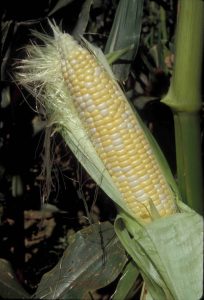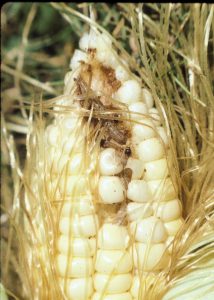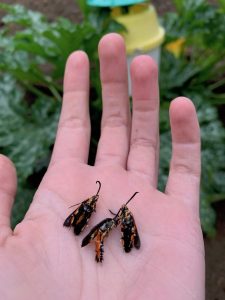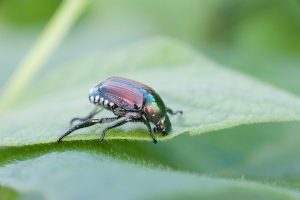Sweet Corn IPM Newsletter- No. 2- July 9, 2021

Sweet Corn IPM Newsletter- No. 2- July 9, 2021
Click on photos to enlarge.
EARLY TROPICAL STORM BRINGS CORN EARWORM THREAT
Early Silking Fields May Require Protection
SITUATION
The hot weather, which pushed corn development into very early silking, appears to be over, at least for now, and a tropical storm moving up the East Coast may bring more relief to dry soils. However, the track of the storm suggests that it may also bring corn earworm and fall armyworm moths into Maine as it moves from Southern states northward. Early planted corn with plastic mulch or rowcovers is now silking in many fields, making it susceptible to any arriving corn earworm moths. European corn borer is now active and feeding on leaves of young corn and moving into tassels and stalks of silking corn.

European Corn Borer:
Larval feeding injury was over the 15% control threshold for pre-tassel corn in Sabattus this week, and feeding activity was observed in most fields. Sprays during the pre-tassel stage, when both moths and larvae are present, can control larvae before they move into the stalks and ears where they will be protected. Once corn reaches the silk stage, sprays may be based on the number of moths caught in pheromone traps. Moths will lay eggs on flag leaves of silking corn, and the larvae can move into the ears without leaving visible feeding injury. If more than five moths are caught during a week in silking corn, a spray is recommended. However, none of the European corn borer trap counts were over the spray threshold for silking corn this week.

Corn Earworm:
We are still in the process of setting up earworm traps around the state this week. Although we haven’t caught any moths yet, reports from New York and Massachusetts indicate the earworm is active in those states, but at relatively low levels. The tropical storm front expected to come through Maine this weekend is likely to bring up earworm moths from southern states. So, growers with early silking corn may want to protect those fields. Corn earworm moths lay eggs on fresh silking corn, the recommended frequency of sprays depends on the number of moths present at a site (see table below). More moths will require more frequent sprays to provide good control.

Fall Armyworm:
We have not caught any fall armyworm moths in Maine, nor seen any feeding damage in the field. There have not yet been any reports of fall armyworm from Massachusetts or New Hampshire. This may change soon as a result of the tropical storm front moving in from the south.

Squash vine borer moths are likely to become active soon. We will be setting up traps at several locations next week. Growers in Southern Maine should scout squash and pumpkin fields for squash vine borer feeding at the base of the plants and/or wilting vines now, and apply appropriate control if damage is found. Squash vine borer moths are black and orange and resemble wasps. They lay their eggs at the base of squash plants. The larvae bore into the base of the plants, causing vines to wilt and collapse. See the 2020-2021 New England Vegetable Management Guide for control options.

Potato leafhopper alert:
Potato leafhopper is now active in vegetable and berry fields. These small, bullet-shaped insects feed on plant sap from the undersides of leaves, causing the leaves to become curled, stunted and yellow-streaked. Beans are often the first crop to show symptoms, but other crops are also susceptible, including potatoes, peppers, eggplant, strawberries and raspberries. To scout for leafhoppers, brush the leaves of the plants with your hand. The small, whitish adults can be seen flying off the plant. Look for small, light green leafhopper nymphs on the underside of injured leaves. They are about 1/16 inch long. When touched, they will crawl sideways in a crab-like manner. Control options for potato leafhoppers are listed in the New England Vegetable Management Guide.

Japanese beetles are now appearing in southern and mid-state areas. These insects often find their way into cornfields and feed on the leaves, causing an interveinal skeletonizing, which is generally not significant. However, they may also feed on the silks of developing ears, causing poor tip fill. Sprays for European corn borer and/or corn earworm (except Bt’s) usually will control Japanese beetles as well.
Deer have been active in several fields this week, and damage corn by chewing off the fresh silks and tips of the ears. Fencing, including temporary electric fences, can do a good job of deterring deer if they are set up before the animals get accustomed to feeding in a field. Be sure to call your local Game Warden if you are seeing a significant problem and want to try controlling deer intrusions.
Sincerely,
David T. Handley
Vegetable and Small Fruit Specialist
Highmoor Farm Pest Management Unit
P.O. Box 179 17 Godfrey Drive
52 U.S. Route 202 Orono, ME 04473
Monmouth, ME 04259
207.933.2100 1.800.287.0279
| Moths caught per week | Moths caught per night | Spray interval |
|---|---|---|
| 0.0 to 1.4 | 0.0 to 0.2 | No spray |
| 1.5 to 3.5 | 0.3 to 0.5 | Spray every 6 days |
| 3.6 to 7.0 | 0.6 to 1.0 | Spray every 5 days |
| 7.1 to 91 | 1.1 to 13.0 | Spray every 4 days |
| More than 91 | More than 13 | Spray every 3 days |
Thresholds apply only to corn with exposed fresh silk. Lengthen spray intervals by one day if maximum daily temperature is less than 80°F.
European Corn Borer Thresholds
Whorl stage: 30% or more of plants scouted show injury.
Pre-tassel-silk: 15% or more of plants scouted show injury.
Silk: 5 or more moths caught in pheromone traps in one week.
IPM Web Pages:
UMaine Cooperative Extension IPM
Where brand names or company names are used, it is for the reader’s information. No endorsement is implied nor is any discrimination intended against other products with similar ingredients. Always consult product labels for rates, application instructions and safety precautions. Users of these products assume all associated risks.
The University of Maine is an equal opportunity/affirmative action institution.
